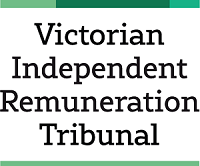On this page
On 20 June 2023, the Tribunal made a new Determination — the Members of Parliament (Victoria) Determination No. 01/2023 — setting the values of salaries, allowances and the Electorate Office and Communications Budget (EO&C Budget) for Members of the Parliament of Victoria (MPs). The Determination took effect on 1 July 2023.
The Determination and accompanying the Statement of Reasons, which outlines in detail the Tribunal's considerations, are available here:
On 20 June 2023, the Tribunal also made the Members of Parliament (Victoria) Guidelines No. 01/2023 (MP Guidelines), which set rules and eligibility criteria for the use of certain work-related parliamentary allowances and the EO&C Budget. The MP Guidelines took effect on 1 July 2023.
Summary
The Tribunal’s considerations and decisions in making the Determination and MP Guidelines are summarised below.
In setting the values of MP salaries and allowances, the Tribunal strives to achieve fair and reasonable recompense for MPs in performing their public duties.
The Tribunal examined the roles and responsibilities of MPs, including specified parliamentary office holders, and comprehensively reviewed the salaries, work‑related parliamentary allowances and other funding, superannuation and pension arrangements provided to them.
The Tribunal took into account the salary and allowances for, and roles and responsibilities of, Members of the Parliaments of the Commonwealth and other States and Territories, as well as guidelines and rulings governing the use of work-related parliamentary allowances and the EO&C Budget, including relevant rulings by the Australian Taxation Office.
The Tribunal gave close consideration to the financial position and fiscal strategy of Victoria, current and projected economic conditions and trends and the Victorian Government’s Wages Policy.
The Tribunal also considered the submissions it received in relation to the Determination. The Tribunal expresses its appreciation to those who made submissions and to the MPs who participated in the consultative group.
Consistent with legislative requirements, the Tribunal ensured that individual MPs are in an overall position that is no less favourable than the arrangements in place before the making of the Determination, taking into account the basic salary, additional salary, the EO&C Budget, work-related parliamentary allowances, superannuation and pension arrangements.
The Tribunal set the value of the basic salary for an MP at $198,839 per annum. This represents an annual increase of 3.5%.
The Tribunal also set the values of the additional salaries and expense allowances for specified parliamentary offices. Additional salaries for specified parliamentary offices range from $7,954 to $221,871 per annum. Expense allowances for eligible specified parliamentary offices range from $3,558 to $60,480 per annum. These decisions also represent an annual increase of 3.5%.
In setting these values, the Tribunal gave particular weight to the current Wages Policy, the Victorian Government’s financial and fiscal objectives and prevailing economic conditions and trends.
The Tribunal set the values of several work-related parliamentary allowances, which are provided to MPs to assist them in performing their public duties. The values of three allowances — the electorate, motor vehicle and commercial transport allowances — continue to vary depending on the size of the MP's electorate. This recognises the additional costs incurred by MPs in serving larger electorates.
The value of the electorate allowance — which is to cover costs associated with providing services to constituents — ranges from $45,022 to $53,933 per annum. This represents an increase of 6.8%, consistent with the annual change in the Melbourne Consumer Price Index (CPI).
The value of the motor vehicle allowance — available to MPs who elect not to be provided with a fully maintained motor vehicle — ranges from $23,225 to $34,994 per annum. This represents an increase of 3.9%, consistent with the annual change in the ‘Transport’ component of the Melbourne CPI.
The value of the commercial transport allowance — available on a reimbursement basis for eligible transport costs — ranges from $5,195 to $17,898 per annum. This represents an increase of 3.9%, also reflecting changes in the 'Transport' component of the Melbourne CPI.
The value of the international travel allowance — available on a reimbursement basis for eligible international travel costs — was set as $10,765 per annum for all MPs. This represents an increase of 6.8%.
The Tribunal continued to link the value of the travel allowance — available on a reimbursement basis for eligible domestic travel costs — to rates set by the Commonwealth Remuneration Tribunal.
The Tribunal did not change the values of the parliamentary accommodation sitting allowance — provided to MPs in certain regional electorates who choose to maintain a residence in metropolitan Melbourne to help them carry out their public duties — which ranges from $26,609 to $53,217.
The Tribunal reset the formulas used to calculate the value of an MP’s EO&C Budget. The effective rate per voter has been increased by 6.8%, consistent with the annual change in the Melbourne CPI.
The formulas are contained in Part 4 of the Determination, and are also summarised here.
The Tribunal has the power to make guidelines for, or with respect to the use of, certain work-related parliamentary allowances and the EO&C Budget.
The new MP Guidelines aim to better support MPs to carry out their public duties, consistent with legislative principles and overarching obligations.
The new MP Guidelines provide MPs with greater flexibility in using the EO&C Budget to communicate with their electorate, including by allowing an MP to communicate with their constituents on any matter that they reasonably believe is of importance or interest to them, subject to the legislative framework and prohibitions on party political activity. They also enable joint communication between two or more MPs from any geographical location or House of Parliament.
The new MP Guidelines also clarify:
- that an MP may claim the travel allowance for an overnight stay immediately preceding and following their parliamentary business, committee business or Ministerial business
- that an MP must not make a claim under the EO&C Budget for costs incurred or activity undertaken to communicate with their electorate between the issuing of writs for a general election or by-election and the declaration of the poll for the electorate
- the arrangements for an MP to carry over unspent funds from the EO&C Budget remaining from a pre-election period, including where an MP is elected to a different electorate.
Consultation process
The Tribunal carried out stakeholder consultation to support the making of the Determination.
On 15 December 2022, the Tribunal published notice of its intention to make the Members of Parliament (Victoria) Determination No. 01/2023.
The notice of intention called for submissions from all interested parties. To support interested parties to make a submission, the Tribunal also published a Consultation Paper as part of the notice of intention.
The notice of intention (including the Consultation Paper) and submissions received are available below.
In accordance with section 24(1) of the Victorian Independent Remuneration Tribunal and Improving Parliamentary Standards Act 2019 (Vic) (VIRTIPS Act), the Tribunal hereby publishes notice of its intention to make a Determination setting the values of the salaries and allowances provided to MPs.
Details of the proposed Determination and how to make a submission are set out below.
Submissions and consultation paper
The Tribunal invites submissions from any person or body, including any affected person or class of affected persons, in relation to the proposed Determination.
The Tribunal also invites submissions on whether further changes should be made to the MP Guidelines. These Guidelines were comprehensively reviewed in 2020 and set rules and eligibility criteria for specific allowances and the EO&C Budget.
Submissions (and requests for assistance with making a submission) should be emailed to the Tribunal Secretariat at enquiries@remunerationtribunal.vic.gov.au.
The closing date for submissions is 5pm on 24 February 2023.
Those wishing to make an oral submission must advise the Tribunal via email by 5pm on 10 February 2023.
In addition to this notice of intention, the Tribunal has also published a consultation paper which sets out in further detail the matters it is required to consider in making the Determination and background on the MP Guidelines, and contains specific questions on which feedback is sought.
Read the Consultation paper here
What will the Determination cover?
The Tribunal must make a Determination setting the values of the following salaries and allowances provided to MPs:
- basic salary
- additional salaries for specified parliamentary office holders
- expense allowance
- electorate allowance
- parliamentary accommodation sitting allowance
- travel allowance
- motor vehicle allowance
- commercial transport allowance
- international travel allowance
- EO&C Budget.
The Determination must include a comprehensive review of the existing salaries, work‑related parliamentary allowances and other funding and superannuation and pension arrangements provided to MPs.
Once in effect, the Determination will supersede the Tribunal’s Members of Parliament (Victoria) Determination No. 01/2019 (as amended by annual adjustments made in 2020, 2021 and 2022).
When will the Tribunal make its Determination?
In accordance with section 17(7) of the VIRTIPS Act, the Tribunal must make its Determination no later than 20 June 2023, that is, within six months of the first sitting of the 60th Parliament of Victoria.
Publication of submissions
The Tribunal may use information provided in submissions in its Determination.
All submissions will be published in full or in summary form on the Tribunal’s website, unless the person making the submission seeks confidentiality or the submission contains information that is identified as commercially sensitive. In this instance, the submission will be published in a form which protects confidentiality or commercially sensitive information.
The Tribunal may remove identifying information from submissions if published.
Submissions that contain offensive or defamatory comments, or that are outside the scope of the Determination, will not be published.
The Tribunal may receive a request under the Freedom of Information Act 1982 (Vic). Any such request will be determined in accordance with the Freedom of Information Act 1982 (Vic) which contains provisions designed to protect personal information and information given in confidence. Further information can be found on the website of the Office of the Victorian Information Commissioner.
How will the Tribunal make its Determination?
The Tribunal aims to ensure fair and reasonable recompense for MPs, helping to attract and retain talented MPs that effectively represent the interests of the community. The Tribunal does not assess the performance of any individual MP or group of MPs when making its Determinations.
In making its Determination, the Tribunal is required by the VIRTIPS Act to:
- not set the basic salary at a rate that is higher than the basic salary for Commonwealth MPs
- take into account the salary and allowances for, and the roles and responsibilities of, MPs in other Australian jurisdictions
- take into account existing guidelines and rulings governing the use of work-related parliamentary allowances and the EO&C Budget, including any relevant rulings by the Australian Taxation Office
- ensure that individual MPs are in an overall position that is no less favourable than the arrangements that are in place before the making of the Determination, taking into account the basic salary, additional salary, the EO&C Budget, work-related parliamentary allowances and superannuation and pension arrangements
- in setting the value of the electorate allowance, take into account that the purpose of the electorate allowance is for costs associated with MPs providing services to their constituents.
As with each of its Determinations, the VIRTIPS Act also requires the Tribunal to take account of the following factors:
- any statement or policy issued by the Government of Victoria which is in force with respect to its wages policy (or equivalent) and the remuneration and allowances of any specified occupational group
- the financial position and fiscal strategy of the State of Victoria
- current and projected economic conditions and trends
- submissions received in relation to the proposed Determination.
Current and projected economic conditions and trends
Data from the Australian Bureau of Statistics (ABS) show that Australia’s Gross Domestic Product (GDP) increased by 0.6% in the September quarter 2022, resulting in overall growth of 5.9% over the year to September 2022. The ABS reported that growth was largely driven by strength in household spending.
Regarding the labour market, the national unemployment rate decreased to 3.4% in October 2022, while the participation rate (in seasonally-adjusted terms) remained at 66.5%.
Data from the ABS also show that the Australian Consumer Price Index (CPI) increased by 7.3% over the 12 months to the September quarter 2022. This is the highest annual growth in the CPI since 1990. The trimmed mean — which measures underlying inflation — grew by 6.1% over the same period. Meanwhile, the Australian Wage Price Index (WPI) increased by 3.1% over the 12 months to the September quarter 2022.
In response to inflationary pressures, the Reserve Bank of Australia (RBA) has raised its target for the cash rate at each of its monthly meetings since May 2022. These increases — the first since November 2010 — have brought the cash rate target from an all-time low of 0.1% to 3.1% as at December 2022. In his Statement of 6 December 2022 announcing a further increase in the cash rate target, RBA Governor Dr Philip Lowe flagged further increases over the period ahead. Dr Lowe stated that the ‘size and timing of future interest rate increases will continue to be determined by the incoming data and the [RBA] Board’s assessment of the outlook for inflation and the labour market’.
In its latest Statement on Monetary Policy (November 2022), the RBA reported the following outlook for the Australian economy:
- GDP is forecast to grow by 3% over 2022 and 1.5% over 2023
- the national unemployment rate is forecast to remain around 3.5% until mid-2023, before rising as economic growth slows
- CPI growth is expected to peak at around 8% in late-2022, before slowing to 3.25% (just above the top of the RBA’s target range of 2 to 3%) by the end of 2024
- WPI growth is forecast to increase to around 3.75% by mid-2023 and 4% by mid-2024.
Data from the ABS show that Victoria’s Gross State Product (GSP) rose 5.6% over 2021-22, the highest increase of all of Australia’s states and territories. In October 2022, the Victorian unemployment and participation rates remained steady at 3.5% and 66.8%, respectively.
The Tribunal notes the following movements in prices and wages in the Victorian economy:
- Melbourne CPI grew by 7.4% over the 12 months to the September quarter 2022
- Victorian WPI grew by 3.1% over the 12 months to the September quarter 2022
- average weekly ordinary time earnings for full-time Victorian adults (in seasonally-adjusted terms) decreased by 0.02% over the 12 months to May 2022.
The 2022 Victorian Pre-Election Budget Update (November 2022) reported the following economic outlook for Victoria:
- real GSP is forecast to grow by 3% in 2022-23, and by 1.75% in 2023-24
- the Victorian unemployment rate is expected to average 3.75% in 2022-23 and 4% in 2023‑24
- annual growth in the Melbourne CPI is expected to average 7.25% in 2022-23 and 4% in 2023-24
- annual growth in the Victorian WPI is expected to average 3.25% in 2022-23 and 3.5% in 2023-24.
Financial position and fiscal strategy of the State of Victoria
According to the State’s 2021/22 Financial Report, the Victorian general government sector recorded an operating deficit of $13.8 billion in 2021-22. Meanwhile, net debt was $100 billion (19.4% of GSP) as at 30 June 2022.
The 2022 Victorian Pre-Election Budget Update (November 2022) forecast an operating cash surplus for 2022-23, ahead of an expected return to an operating surplus in 2025-26. Net debt is forecast to be $116 billion (20.3% of GSP) in June 2023 and $166 billion (24.6% of GSP) by June 2026.
The 2022 Victorian Economic and Fiscal Update (October 2022) reiterated the Victorian Government’s commitment to the 4-step fiscal strategy outlined in the Victorian Budget 2020/21:
- Step 1: creating jobs, reducing unemployment and restoring economic growth
- Step 2: returning to an operating cash surplus
- Step 3: returning to operating surpluses
- Step 4: stabilising debt levels.
Wages Policy
The VIRTIPS Act requires the Tribunal to consider any statement or policy issued by the Victorian Government which is in force with respect to its Wages Policy (or equivalent) and the remuneration and allowances of any specified occupational group.
The Victorian Government Wages Policy and Enterprise Bargaining Framework (Wages Policy), which applies to departments and agencies in the Victorian public sector, is reproduced below.
The Victorian Government Wages Policy and Enterprise Bargaining Framework has three pillars:
- Pillar 1: Wages — increases in wages and conditions will be capped at a rate of growth of 1.5% per annum over the life of the agreement. In practice, this means employee wages and conditions will be allowed to grow at this rate.
- Pillar 2: Best Practice Employment Commitment — all public sector agencies will be required to make a Best Practice Employment Commitment which will outline measures to operationalise elements of the Government’s Public Sector Priorities that reflect good practice within Government and can be implemented operationally or without significant costs.
- Pillar 3: Additional strategic changes — additional changes to allowances and other conditions (not general wages) will be capped at 0.5% per annum of the salary base and will only be allowed if Government agrees that the changes will address key operational or strategic priorities for the agency, and/or one or more of the Public Sector Priorities.
A ‘Secondary Pathway’ is also available for public sector agencies whose current enterprise agreement reaches its nominal expiry date on or before 31 December 2022 which permits one annual wage and allowance increase capped at 2% (instead of at 1.5%).
Source: Industrial Relations Victoria (2022), ‘Victorian Government Wages Policy,’ Wages Policy and the Enterprise Bargaining Framework.
Updated


